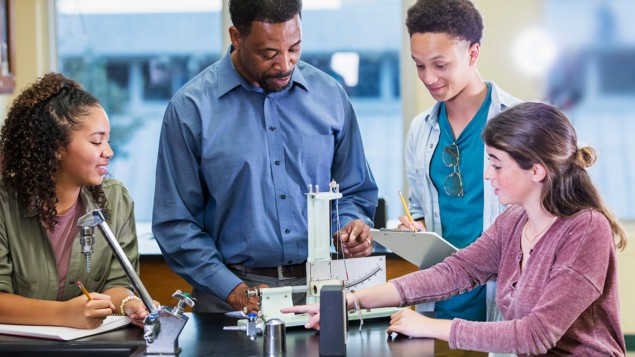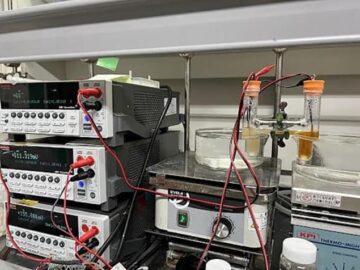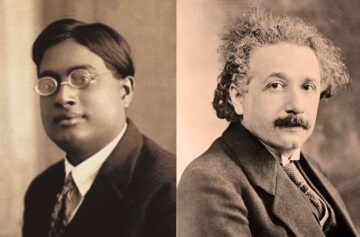The shortage of physics teachers in the UK has led the UK government to set up a new apprenticeship scheme that it hopes will help encourage more people into the profession. But with high workloads and low pay causing many teachers to quit, Katherine Skipper asks if this latest scheme will be enough to fix the issue

Very few world-changing physics breakthroughs happen in a classroom, but many of them started there. However, an increasing number of young people in the UK simply do not have access to a specialist physics teacher. In 2022 the number of physics teachers recruited was only 17% of the government’s target, and the Institute of Physics (IOP) estimates that an additional 3500 teachers are needed to make up the shortage.
This leaves young people at the mercy of a postcode lottery, with schools in socioeconomically disadvantaged areas more likely to suffer
Hari Rentala, head of learning and skills at the IOP
Hari Rentala, head of learning and skills at the IOP, says that in some areas of the UK, schools struggle to recruit a single specialist physics teacher. “This leaves young people at the mercy of a postcode lottery, with schools in socioeconomically disadvantaged areas more likely to suffer,” It is no understatement to say that the future of the next generation of physicists is at stake.
The urgent need for more physics teachers is one reason why the UK government earlier this year launched a new recruitment pathway called “teacher degree apprenticeships” (TDAs). Physicists who want to become teachers currently have to do a degree followed by a postgraduate teaching qualification. TDAs are four-year degrees, but students would spend only 40% of their time in university and the rest working in a school. Prospective teachers will therefore earn money as they study.
The vicious circle of physics teacher shortages
Teaching is often described as a vocation – it is rewarding to instil a passion for physics in young people, but it isn’t as well paid as many pathways available to physics graduates. According to the 2023 Science Teacher Survey, which was supported by the IOP and received more than 3700 responses from teachers and technicians, low pay is one of many barriers to recruitment and retention.
The challenge of recruiting enough physics teachers is made worse by the fact that almost half of new physics teachers leave within their first five years of qualifying. One reason for the high attrition rate is that in England it is common for physics teachers to also cover chemistry and biology despite not having specific expertise in those areas. “This has the potential to decrease job satisfaction and increase workload, especially for newly qualified teachers who may not have studied the other sciences for many years,” says Rentala.
This can leave physics teachers feeling isolated and – especially in their early years – without sufficient access to the informal subject-specific mentoring and support that most of us turn to when we begin our careers
Hari Rentala
The situation is different in Scotland. Physics teachers there generally only teach physics, which leads to them staying far longer in the profession. Rentala says eight times as many physics teachers leave after the first two years in England compared with Scotland. Indeed, many physics graduates who do decide to become teachers in England end up training as maths teachers to avoid teaching subjects in which they do not have a specialism.
However, teacher retention is a UK-wide issue, with more than half of the respondents to the survey reporting that their school had a shortage of physics teachers. “This can leave physics teachers feeling isolated and – especially in their early years – without sufficient access to the informal subject-specific mentoring and support that most of us turn to when we begin our careers,” Rentala says.
As a result of the overall shortage, physics teachers gravitate towards high-achieving schools in more affluent areas, which threatens to entrench regional and economic inequality. In England, for example, 70% of physics A-level students come from only 30% of schools. But will the new TDAs make a difference?
Alternative pathways for physics teachers
Charles Tracy, the IOP’s senior adviser for learning and skills, thinks that TDAs are an efficient way to become a teacher. “Otherwise, they’d have to take a physics degree and learn lots of things that they would never otherwise use in their teaching.” Depending on the course, apprentices might not learn content like, say, relativity and quantum mechanics, which generally do not appear on school syllabuses.
TDAs are due to start accepting applications later this year, with the first cohort of apprentices beginning their training in 2025, although it is not clear which universities will be offering the courses. Tracy, however, thinks that the scheme might particularly appeal to people who are already working in schools, such as teaching assistants or computer or lab technicians.
[There’s a] need for a laser-like focus on improving recruitment and retention – which must involve government action to improve pay, reduce workload and make the accountability systems…less punitive
Geoff Barton, general secretary of the Association of School and College Leaders
But TDAs will only ever be part of the solution. Geoff Barton, general secretary of the Association of School and College Leaders, says that while the principle behind the apprenticeships is good, the pilot scheme of 150 recruits will be a “drop in the ocean”.

IOP Teacher Training Scholarships: opening up new opportunities whatever your background
“The main event is the challenge that exists right now, and this involves the need for a laser-like focus on improving recruitment and retention – which must involve government action to improve pay, reduce workload and make the accountability system of Ofsted inspections and performance tables less punitive.”
As well as supporting the apprenticeship scheme, the IOP is backing plans announced last year to reform secondary curricula in the UK. Rentala believes that ensuring that physics teachers only teach their specialist subject would tackle the high attrition of physics teachers by reducing workload and allowing teachers to focus on the topics that they are passionate about. But he adds that organizations like the IOP cannot do everything on their own. “This is a complex issue and one where the real step-changes can ultimately only be unlocked through government policy.”
- SEO Powered Content & PR Distribution. Get Amplified Today.
- PlatoData.Network Vertical Generative Ai. Empower Yourself. Access Here.
- PlatoAiStream. Web3 Intelligence. Knowledge Amplified. Access Here.
- PlatoESG. Carbon, CleanTech, Energy, Environment, Solar, Waste Management. Access Here.
- PlatoHealth. Biotech and Clinical Trials Intelligence. Access Here.
- Source: https://physicsworld.com/a/tackling-the-uks-physics-teacher-shortage-with-a-new-apprenticeship-scheme/
- :has
- :is
- :not
- :where
- $UP
- 150
- 160
- 2022
- 2025
- 90
- a
- About
- accepting
- access
- According
- accountability
- Action
- Additional
- Adds
- adviser
- After
- Allowing
- almost
- already
- also
- Although
- an
- and
- announced
- appeal
- appear
- applications
- ARE
- areas
- AS
- assistants
- Association
- At
- attrition
- available
- avoid
- backing
- barriers
- BE
- become
- begin
- Beginning
- behind
- believes
- biology
- breakthroughs
- but
- by
- called
- CAN
- cannot
- careers
- causing
- challenge
- chemistry
- Circle
- classroom
- clear
- Cohort
- College
- come
- Common
- compared
- complex
- computer
- content
- could
- course
- courses
- courtesy
- cover
- Currently
- decide
- decrease
- Degree
- Depending
- described
- Despite
- difference
- different
- do
- due
- Earlier
- Early
- earn
- Economic
- efficient
- eight
- encourage
- end
- England
- enough
- ensuring
- especially
- Event
- EVER
- everything
- example
- exists
- expertise
- facing
- fact
- far
- feeling
- few
- First
- five
- Fix
- Focus
- followed
- For
- from
- future
- General
- generally
- generation
- good
- Government
- Government policy
- Growing
- had
- Half
- happen
- Have
- having
- he
- head
- help
- High
- hopes
- However
- HTTPS
- if
- improve
- improving
- in
- Increase
- increasing
- indeed
- Inequality
- informal
- information
- Institute
- into
- involve
- involves
- isolated
- issue
- IT
- Job
- jpg
- lab
- Last
- Last Year
- later
- latest
- launched
- leaders
- Leads
- LEARN
- learning
- Leave
- leaves
- Led
- less
- like
- likely
- longer
- lots
- lottery
- Low
- made
- Main
- make
- many
- mark
- max-width
- May..
- mechanics
- mentoring
- mercy
- might
- money
- more
- most
- must
- Need
- needed
- never
- New
- newly
- next
- no
- now
- number
- of
- offering
- often
- on
- ONE
- only
- opening
- opportunities
- or
- organizations
- Other
- otherwise
- our
- overall
- own
- paid
- parliament
- part
- particularly
- passion
- passionate
- pathway
- pathways
- Pay
- People
- performance
- Physics
- Physics World
- pilot
- plans
- plato
- Plato Data Intelligence
- PlatoData
- policy
- postgraduate
- potential
- principle
- Problem
- profession
- prospective
- qualification
- qualified
- qualifying
- Quantum
- Quantum Mechanics
- Rate
- real
- reason
- received
- recruit
- recruiting
- recruitment
- Recruits
- reduce
- reducing
- reform
- regional
- relativity
- Reporting
- respondents
- responses
- REST
- result
- retention
- rewarding
- right
- satisfaction
- say
- says
- scheme
- scholarships
- School
- Schools
- Science
- SCIENCES
- Scotland
- secondary
- secretary
- senior
- set
- shortage
- simply
- single
- situation
- skills
- solution
- some
- specialist
- specific
- spend
- stake
- start
- started
- staying
- Struggle
- Students
- studied
- Study
- subject
- such
- suffer
- sufficient
- support
- Supported
- Supporting
- Survey
- system
- tackle
- tackling
- Take
- Target
- teacher
- teachers
- Teaching
- technicians
- than
- that
- The
- The Future
- the UK
- their
- Them
- There.
- therefore
- they
- things
- Thinks
- this
- this year
- those
- threatens
- three
- Through
- thumbnail
- time
- times
- to
- Topics
- towards
- tracy
- Training
- TURN
- two
- Uk
- UK government
- Ultimately
- Universities
- university
- unlocked
- urgent
- us
- use
- want
- was
- Way..
- we
- WELL
- whatever
- when
- which
- while
- WHO
- why
- will
- with
- within
- without
- working
- world
- world-changing
- worse
- would
- year
- years
- young
- Your
- zephyrnet












